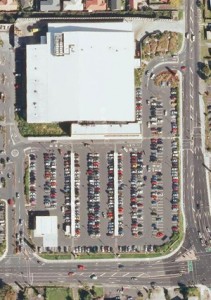Pak’nSave’s Great Example of a Large White Roof – Reducing C02
 An excerpt from Ian Montangees ‘White Roofs NZ’ newsletter which you can sign up to here.
An excerpt from Ian Montangees ‘White Roofs NZ’ newsletter which you can sign up to here.
PAK’nSAVE supermarkets around Auckland are known for their trademark yellow frontage but what is not well  known is that they also have good examples of large white roofs. The colour white was most likely deliberately chosen (walls as well as roof except for the yellow facade) because these supermarkets need to be kept cool during summer to help protect the many food items from perishing. The white roof also works as an energy saving measure to reduce electricity consumption by air conditioners which would be quite significant.
known is that they also have good examples of large white roofs. The colour white was most likely deliberately chosen (walls as well as roof except for the yellow facade) because these supermarkets need to be kept cool during summer to help protect the many food items from perishing. The white roof also works as an energy saving measure to reduce electricity consumption by air conditioners which would be quite significant.
The satellite photo on the left shows the PAK’nSAVE on Lincoln Rd, Henderson, Auckland, with its white roof in stark contrast to the bitumen paving. The shallow pitched white roof is just visible in the view on the right. Unfortunately the appropriate person to comment on PAK’nSAVE white roofs was out of town this week and not back in time to comment for this newsletter, but perhaps we will get a comment later on. But I can estimate that the 9000 square metre roof (as measured from Google satellite) would reflect enough sunlight back into space to cancel out the global warming of roughly 900 tonne of CO2 emissions, or would be like taking 200 cars off the road for one year (this calculation applies results of overseas studies without modifying for these NZ conditions – see note bottom of the Science page on our website). In addition to that a further tonnage of CO2 emissions are saved annually from reduced electricity generation needed by the reduced air conditioning use. I hope to have a figure for CO2 emissions saved per square metre of typical roofing like this sometime later on when there is time and money to investigate. About 40% of NZ’s electricity generation is from fossil fuels, but at peak times when the hydro dams are operating to their maximum it could be said that any increase is 100% fossil fuelled because more fossil fuel power plant needs to be fired up to meet the extra demand, which are normally kept in reserve because they are more expensive to run than hydro.
loading...
loading...
